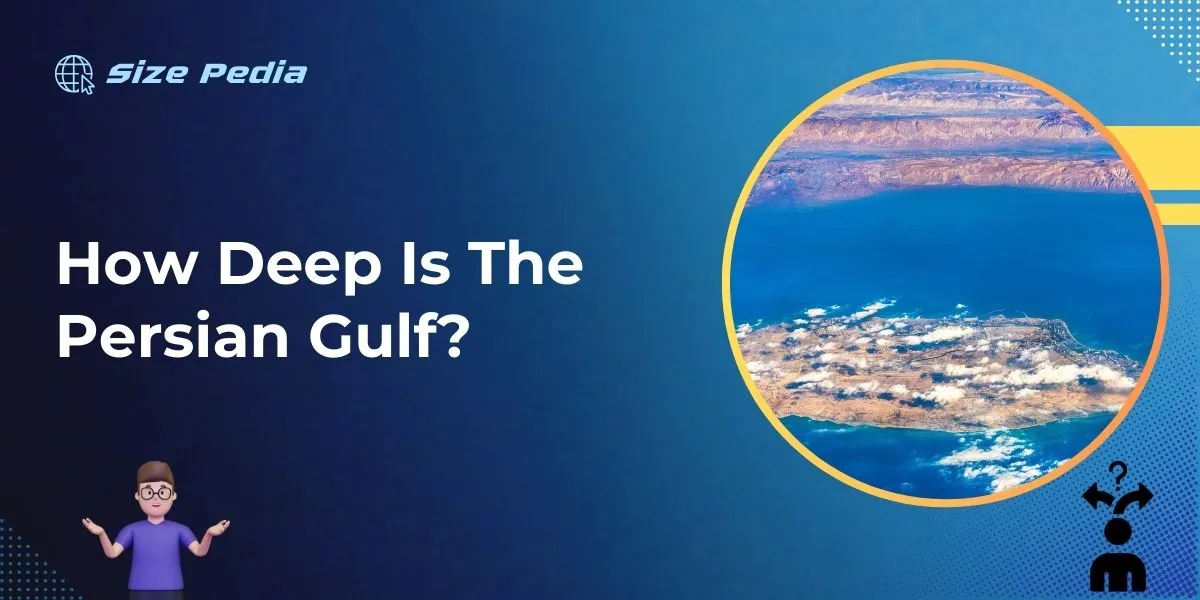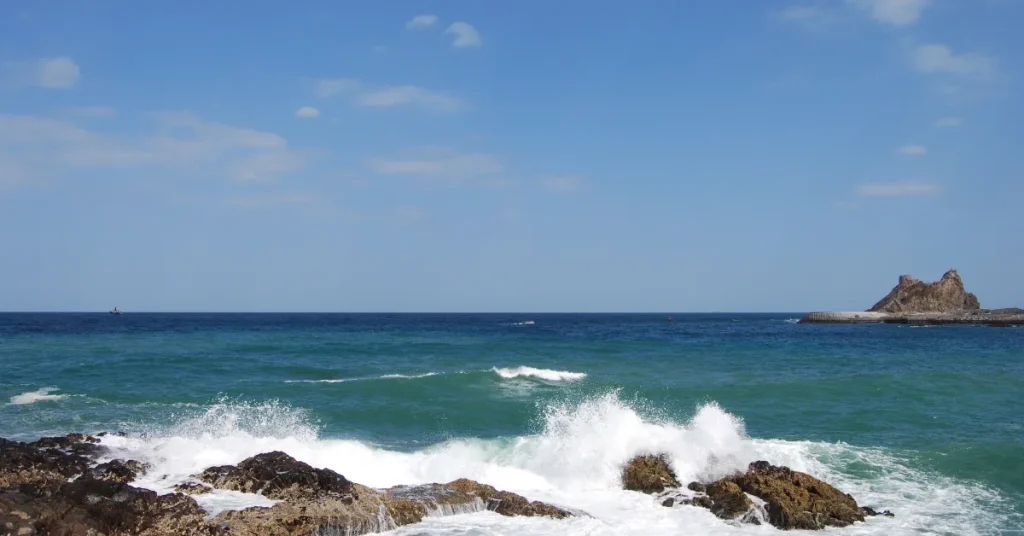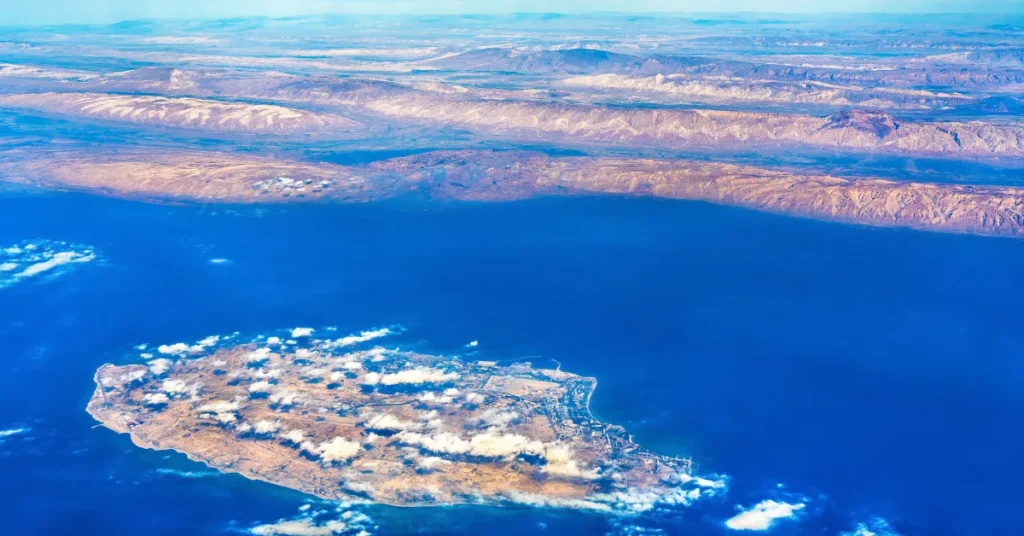The Persian Gulf has an average depth of 50 meters (164 feet). Its deepest point is the Strait of Hormuz, at 90 meters (300 feet).
Exploring the depths of the Persian Gulf reveals a shallow marginal sea of the Indian Ocean nestled between Iran and the Arabian Peninsula.
Spanning approximately 989 kilometers (615 miles) long, this body of water plays a crucial role in international commerce, particularly in the oil industry.
The unique geological formations within its basins, rich marine life, and critical shipping lanes make the Gulf a vital asset for bordering countries.
As a vital conduit for maritime trade, the Persian Gulf’s depth affects everything from the types of vessels that can navigate its waters to the marine ecosystems that flourish beneath its surface.
Understanding its bathymetry is essential for safe navigation, environmental protection, and maintaining the region’s economic vitality.

The Mysteries Of The Persian Gulf
The Mysteries of the Persian Gulf captivate the imagination with tales of ancient civilizations and modern-day marvels. This extraordinary body of water holds secrets beneath its surface, some of which have fascinated scholars and adventurers alike for centuries.
From the rich history embedded in the seafloor to the ongoing discoveries that push the boundaries of science, the Persian Gulf is a place of enigma and wonder.
Ancient Tales And Modern Exploration
The depths of the Persian Gulf have always been shrouded in mystery. Ancient cultures shared stories of submerged cities and hidden treasures, luring explorers to this enticing region.
Modern research, equipped with cutting-edge technology, continues to peel back the layers of time.
Exciting underwater archaeological digs reveal insights into long-lost civilizations, while technological advancements enable explorers to survey regions previously untouched by human hands.
Key Factors Influencing Depth Variations
The Persian Gulf’s depth is not uniform; it fluctuates due to several key factors. Tectonic movements can cause shifts in the seabed, creating deep trenches or shallow banks.
Sediment deposition from rivers, particularly the Shatt al-Arab, affects the depth along with currents and wind patterns that influence sand distribution.
Temperature and salinity levels also play roles in the unique bathymetric profile of the region.
Measuring Ocean Depths

The Persian Gulf, a marginal sea of the Indian Ocean, poses an intriguing enigma for oceanographers. Its depth, not uniform across the expanse, is a measure pivotal to understanding various marine and geopolitical dynamics.
Here we delve into how experts discern the depths of such oceanic stretches, focusing on the Persian Gulf’s distinctive undersea landscape.
Traditional And Advanced Techniques
Scientists use diverse methods to chart the seabed in their quest to quantify ocean profundity.
- Echo Sounding: A widely used technique where a sound pulse is sent from a ship to the sea bottom, bouncing back to reveal depths.
- LIDAR: Employs light detection and ranging to map the seafloor.
- Satellite Altimetry: Uses satellite measurements to infer sea floor topography indirectly.
These methods, ranging from the classic lead line to space-borne platforms, reflect the evolution in ocean surveying. They offer a glimpse into the underwater realm with increasing accuracy and detail.
Challenges In Underwater Surveying
The Persian Gulf’s seafloor mapping presents specific hurdles:
- High salinity impacts the accuracy of sonic equipment.
- Offshore activities can interfere with data collection.
- Shallow areas necessitate precise navigation to avoid ship grounding.
Addressing these obstacles requires fine-tuned instruments and skillful navigation. With these measures, the deepest point in the Persian Gulf, estimated at about 90 meters, becomes discernible.
Ensuring the safety of maritime ventures and a comprehension of environmental dynamics hinges on this continuous, meticulous endeavor of mapping ocean depths.
The Depths Revealed
Unlock the mysteries of how deep the Persian Gulf really is. This storied body of water boasts a varying landscape beneath its surface.
Maximum And Average Depths
The Persian Gulf is known for both its shallow and deep areas. Maximum depths plunge to around 90 meters (295 feet). Its average depth, on the other hand, is approximately 50 meters (164 feet).
| Measurement | Depth |
| Maximum Depth | 90 meters (295 feet) |
| Average Depth | 50 meters (164 feet) |
Geographical Features Affecting The Seabed
The Persian Gulf’s seabed is shaped by various features. Among these are:
- Sandbanks: Create shallow regions.
- Salt domes: Push the seabed upward.
- Submarine trenches: Form deeper areas.
These features make the seabed a tapestry of highs and lows. The presence of oil wells, natural gases, and rich ecosystems owes to these characteristics.
Life In The Depths of Persian Gulf

The Persian Gulf, with depths ranging from shallow shelves to deeper basins, is a marine hub that teams with life. The environment in the depths hosts unique species, each adapted to thrive in the varied levels of darkness and pressure.
These adaptations offer a glimpse into the remarkable world beneath the waves. Let’s dive into the underwater complexities where marine species and ecosystems interact.
Adaptations Of Marine Species
Life in the Persian Gulf displays a showcase of evolution. Creatures have developed extraordinary characteristics to cope with its deep environment.
Fish have specialized gills and slow metabolism to conserve energy. Invertebrates like squid and octopus possess bioluminescence for communication and attracting prey.
- Pressure-resistant structures enable deep-sea dwellers to survive the depths.
- Enhanced sensory organs help locate food in complete darkness.
- Some species have long, needle-like teeth to catch slippery prey.
The Impact Of Depth On The Ecosystem
Variations in depth profoundly affect the Persian Gulf’s ecosystem. Sunlight penetration diminishes with depth, influencing plant life and, by extension, the entire food chain.
Photosynthesis is restricted to the upper layers of the ocean. This dictates the distribution of species and the interactions between them.
Shallower regions are abundant with life, supporting a diverse range of species. Further down, life exists in a balance, dependent on falling organic matter from upper layers. These minimal resources result in a lower density of marine life in the deep.
| Depth Range (meters) | Ecosystem Impact |
| 0-200 | Richest biodiversity, sufficient sunlight for photosynthesis. |
| 200-1000 | Diminishing light, reduced plant life, specially adapted animals. |
| 1000+ | Dark and cold, scavengers and predators dominate. |
Human Activities And Ocean Depths
The Persian Gulf, a vital marine hub, has depths affected by human actions. Oil extraction and maritime traffic are key activities. These activities shape the Gulf’s ecological and geographical landscape.
Effects Of Oil Extraction
Drilling for oil influences the Gulf’s depths. Massive structures penetrate the seabed, altering the underwater environment. Such activities can cause:
- Seafloor subsidence: The ground sinks from the removal of oil.
- Sediment disruption: Drilling stirs up silt and sand.
- Ecosystem changes: Marine life adapts or relocates due to the noise and infrastructure.
Navigation And Maritime Routes
The Persian Gulf is a busy shipping lane. Large ships move through its waters daily. These vessels depend on safe, navigable routes. Operators must understand the depths to prevent accidents. Navigation reshapes the Gulf’s profile by:
- Inducing erosion through waves generated by ship movement.
- Creating deeper channels for safe passage which involves dredging activities.
- Altering marine habitats with the construction of ports and harbors.
FAQs About How Deep Is The Persian Gulf
What Is The Average Depth Of The Persian Gulf?
The Persian Gulf has an average depth of approximately 50 meters. Its shallow nature has significant implications for both marine navigation and regional climate.
How Deep Is The Persian Gulf At Its Deepest Point?
At its deepest point, the Persian Gulf reaches depths of about 90 meters. This deepest area is found in the Gulf’s western part.
Where Is The Shallowest Part Of The Persian Gulf?
The shallowest part of the Persian Gulf is at the Gulf’s northern end. Here, depth measurements can be as little as 10 meters, making it quite shallow.
Does The Persian Gulf Depth Impact Oil Drilling?
Yes, the Persian Gulf’s moderate depth allows for easier access to oil reserves. This has facilitated extensive offshore drilling operations in the region.
Conclusion
Exploring the depths of the Persian Gulf reveals a diverse underwater landscape. This body of water’s depth averages around 50 meters, with its deepest point, the Arvand Rud trench, reaching approximately 90 meters.
As we delve into the Gulf’s marine environment, each discovery enriches our knowledge of this historical and vital region.
Resources:
1. https://earthobservatory.nasa.gov/images/8354/the-persian-gulf
